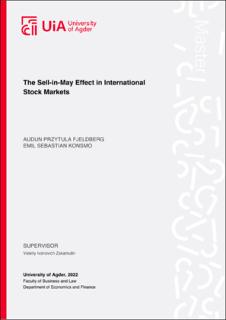| dc.contributor.advisor | Zakamulin, Valeriy Ivanovich | |
| dc.contributor.author | Fjeldberg, Audun Przytula | |
| dc.contributor.author | Konsmo, Emil Sebastian | |
| dc.date.accessioned | 2022-08-13T16:23:18Z | |
| dc.date.available | 2022-08-13T16:23:18Z | |
| dc.date.issued | 2022 | |
| dc.identifier | no.uia:inspera:110159342:22673943 | |
| dc.identifier.uri | https://hdl.handle.net/11250/3011710 | |
| dc.description.abstract | Several studies have presented evidence for higher returns in stock markets from the beginning of November to the end of April compared to the rest of the year. This phenomenon is well known as the Sell-in-May effect. The main focus of this thesis is to investigate whether the Sell- in-May effect still exists in financial markets and whether the power of the effect deviates between time and markets. Additionally, we investigate discrepancies in risk and return between the summer and winter months, as well as the January effect, in order to examine whether these explanations could help us understand the existence of the Sell-in-May effect. In an effort to examine if the investors could exploit and profit from the market anomaly, we developed and simulated a trading strategy based on the Sell-in-May effect and performed various statistical tests against the Buy-and-Hold benchmark strategy. The output from the regression model showed evidence of an existing Sell-in-May effect. Neither the January effect nor differences in risk proved to be viable explanations for the existence of the effect. Further results indicated that the Sell-in-May strategy outperformed the Buy-and-Hold strategy in most scenarios, indicating that investors could exploit and profit from the market anomaly. | |
| dc.description.abstract | | |
| dc.language | | |
| dc.publisher | University of Agder | |
| dc.title | The Sell-in-May Effect in International Stock Markets | |
| dc.type | Master thesis | |
